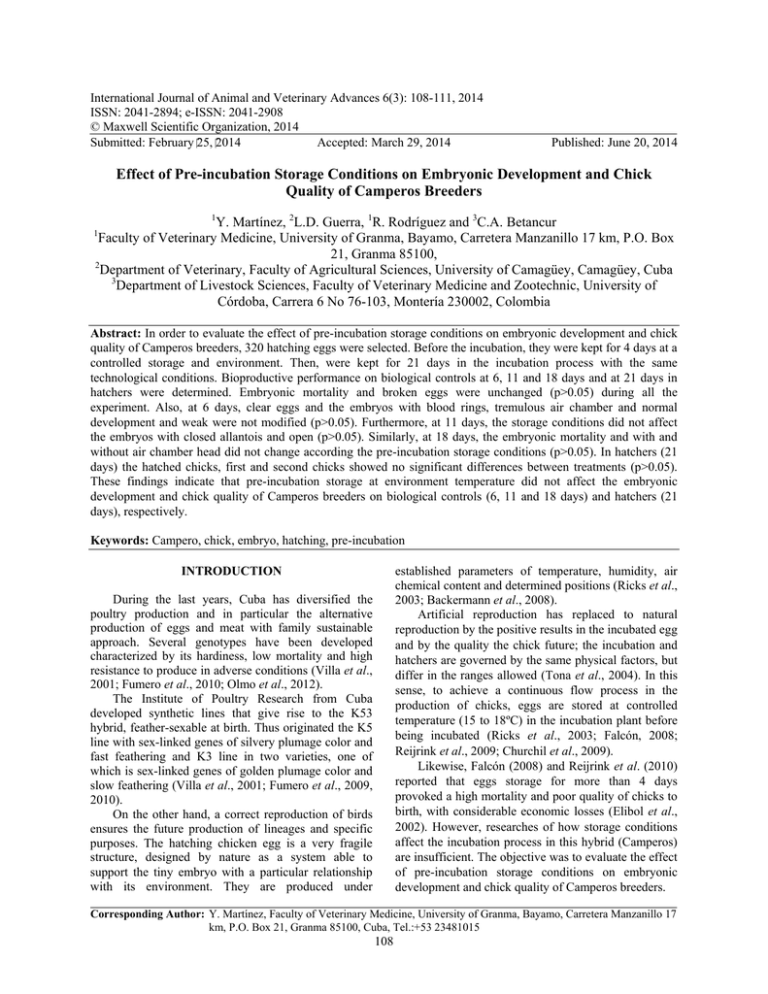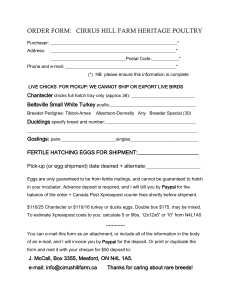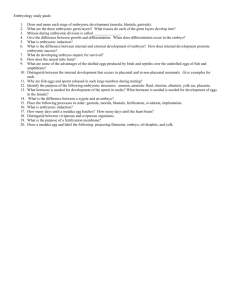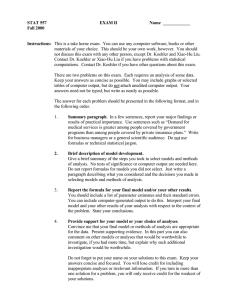International Journal of Animal and Veterinary Advances 6(3): 108-111, 2014
advertisement

International Journal of Animal and Veterinary Advances 6(3): 108-111, 2014 ISSN: 2041-2894; e-ISSN: 2041-2908 © Maxwell Scientific Organization, 2014 Submitted: February 25, 2014 Accepted: March 29, 2014 Published: June 20, 2014 Effect of Pre-incubation Storage Conditions on Embryonic Development and Chick Quality of Camperos Breeders 1 Y. Martínez, 2L.D. Guerra, 1R. Rodríguez and 3C.A. Betancur 1 Faculty of Veterinary Medicine, University of Granma, Bayamo, Carretera Manzanillo 17 km, P.O. Box 21, Granma 85100, 2 Department of Veterinary, Faculty of Agricultural Sciences, University of Camagüey, Camagüey, Cuba 3 Department of Livestock Sciences, Faculty of Veterinary Medicine and Zootechnic, University of Córdoba, Carrera 6 No 76-103, Montería 230002, Colombia Abstract: In order to evaluate the effect of pre-incubation storage conditions on embryonic development and chick quality of Camperos breeders, 320 hatching eggs were selected. Before the incubation, they were kept for 4 days at a controlled storage and environment. Then, were kept for 21 days in the incubation process with the same technological conditions. Bioproductive performance on biological controls at 6, 11 and 18 days and at 21 days in hatchers were determined. Embryonic mortality and broken eggs were unchanged (p>0.05) during all the experiment. Also, at 6 days, clear eggs and the embryos with blood rings, tremulous air chamber and normal development and weak were not modified (p>0.05). Furthermore, at 11 days, the storage conditions did not affect the embryos with closed allantois and open (p>0.05). Similarly, at 18 days, the embryonic mortality and with and without air chamber head did not change according the pre-incubation storage conditions (p>0.05). In hatchers (21 days) the hatched chicks, first and second chicks showed no significant differences between treatments (p>0.05). These findings indicate that pre-incubation storage at environment temperature did not affect the embryonic development and chick quality of Camperos breeders on biological controls (6, 11 and 18 days) and hatchers (21 days), respectively. Keywords: Campero, chick, embryo, hatching, pre-incubation established parameters of temperature, humidity, air chemical content and determined positions (Ricks et al., 2003; Backermann et al., 2008). Artificial reproduction has replaced to natural reproduction by the positive results in the incubated egg and by the quality the chick future; the incubation and hatchers are governed by the same physical factors, but differ in the ranges allowed (Tona et al., 2004). In this sense, to achieve a continuous flow process in the production of chicks, eggs are stored at controlled temperature (15 to 18ºC) in the incubation plant before being incubated (Ricks et al., 2003; Falcón, 2008; Reijrink et al., 2009; Churchil et al., 2009). Likewise, Falcón (2008) and Reijrink et al. (2010) reported that eggs storage for more than 4 days provoked a high mortality and poor quality of chicks to birth, with considerable economic losses (Elibol et al., 2002). However, researches of how storage conditions affect the incubation process in this hybrid (Camperos) are insufficient. The objective was to evaluate the effect of pre-incubation storage conditions on embryonic development and chick quality of Camperos breeders. INTRODUCTION During the last years, Cuba has diversified the poultry production and in particular the alternative production of eggs and meat with family sustainable approach. Several genotypes have been developed characterized by its hardiness, low mortality and high resistance to produce in adverse conditions (Villa et al., 2001; Fumero et al., 2010; Olmo et al., 2012). The Institute of Poultry Research from Cuba developed synthetic lines that give rise to the K53 hybrid, feather-sexable at birth. Thus originated the K5 line with sex-linked genes of silvery plumage color and fast feathering and K3 line in two varieties, one of which is sex-linked genes of golden plumage color and slow feathering (Villa et al., 2001; Fumero et al., 2009, 2010). On the other hand, a correct reproduction of birds ensures the future production of lineages and specific purposes. The hatching chicken egg is a very fragile structure, designed by nature as a system able to support the tiny embryo with a particular relationship with its environment. They are produced under Corresponding Author: Y. Martínez, Faculty of Veterinary Medicine, University of Granma, Bayamo, Carretera Manzanillo 17 km, P.O. Box 21, Granma 85100, Cuba, Tel.:+53 23481015 108 Int. J. Anim. Veter. Adv., 6(3): 108-111, 2014 MATERIALS AND METHODS RESULTS AND DISCUSSION From a total of 1500 hatching eggs of Camperos breeders with average age of 34 weeks, 320 hatching eggs of 1 d of laid were collected randomly; before in the reception area the eggs at a rate of 42 mL formol for 21 g permanganate per m3 were sprayed. The treatments consisted of a control where 160 eggs in the storage area under temperature (15 to 18°C) and relative humidity (75 to 80%) were placed (UECAN, 1998). In the second treatment, 160 eggs under environment conditions of temperature (28±2°C) and relative humidity (82±3%) were stored, a hygrothermograph Deli. (9013, China) was used. This treatment outside the storage area between reception areas and selection and incubation was located. Reports of Falcón (2008) were taken into account for the pre-incubation storage period (4 days) of hatching eggs. All eggs from storage at the same time were taken, the eggs in the control treatment received 6 hours of preheating (20 to 22°C). Multiple hatchery with capacity 5000 eggs in each series was used. The eggs from each treatment were identified and then the eggs with the thick pole at 45 degrees on trays upright were placed. The incubation in strict sense lasted 18 days. Parameters of temperature (37.5 to 37.7°C), relative humidity (53 to 57%), ventilation and mechanical tumbling were governed according the technical standards of the UECAN (1998). In the hatcher (19 to 21 days) eggs horizontally were placed, temperature regimes (36.5 to 36.7°C) and relative humidity (58 to 62%) were automatically controlled (UECAN, 1998). Biological controls to all the eggs at 6, 11 and 18 days to light upon were developed. The following bioindicators were measured: Data on the effect of pre-incubation storage conditions on biological control (6 days) of incubated eggs of Camperos breeders are presented in Table 1. The bioindicators showed no significant differences (p>0.05) among treatments. However, environment storage increased the embryonic dead (2.50%) and decreased the normal development of these (4.38%). According to Klein et al. (2002), Elibol et al. (2002) and Ricks et al. (2003) the hatching eggs should be stored in dry and refrigerated spaces to interrupt the embryonic development to place them in incubators; a default could affect the progress of the future chick. However, the data obtained in this experiment are contradictory, because pre-incubation storage at environment temperature (Table 1) does not statistically affected the technological flow at the hatchery for this type of hybrid (Camperos). Also, the temperature and relative humidity are the main factors in the pre-incubation storage of hatching eggs; it is considered an adequate range in commercial birds between 15 to 18ºC and 75 to 85%, respectively (UECAN, 1998). In this sense, Ricks et al. (2003) reported that these biological structures should be cooled at environment temperature before storage, because the premature cooling of the blastoderm cells causes embryonic mortality. Maybe this hybrid (Camperos) admits other physical parameters for conservation of the egg before hatching, taking into account the results of Table 1. The value of embryonic mortality at environment storage was better than those found by UECAN (2010) and Reijrink et al. (2010) (5.30%) for the first biological control. Several factors that influence in the farm and hatchery in the first 6 days of this process, which can increase the percentage of unfertilized eggs and embryonic dead by deficient in this relation (Fasenko et al., 2001; Guerra et al., 2009). According to Vázquez et al. (2006) and Reijrink et al. (2008, 2009) the embryonic mortality highest rate it observe in the first and last week of incubation. These results may show that embryos of Camperos breeders are more resistant than conventional hybrids. Falcón (2008) had found that pre-incubation storage of hatching eggs from light breeders at environment temperature (4 to 8 d) reduced hatchability and increased embryonic mortality. In this sense, Villa et al. (2001) and Fumero et al. (2009, 2010) indicated that these genotypes are characterized by high resistance to different stress conditions. Table 2 shows the results of the biological control at 11 days of incubated eggs under different conditions of pre-incubation storage. The embryonic mortality, broken eggs, allantois open and allantois closed showed no significant differences (p>0.05) among treatments. However, this last indicator decreased 2.50% in the environment storage. First review (6 days): Embryonic mortality, embryos with normal development and weak, bloodring, air chamber tremulous, clear eggs and broken eggs. Second review (11 days): Embryonic mortality, broken eggs, embryos with allantois closed and open. Third review (18 days): Embryonic mortality, embryos with and without head in air chamber and broken eggs to pass. In the hatcher at 21 days were determined: Hatched chicks, unborn chicks, first and second chicks (UECAN, 1998). To select the first chicks the following parameters were taken into account: Erect and with vitality, live eyes and round, feathered and clean, belly normal, weight and normal size, legs healthy and beak without deformity, dry navel and healthy. The values obtained were analyzed by a comparison of proportions using SPSS computer software 16.01. 109 Int. J. Anim. Veter. Adv., 6(3): 108-111, 2014 Table 1: Effect of pre-incubation storage conditions on biological control (6 days) of incubated eggs of Camperos breeders Storage ----------------------------------Parameters Controlled Environment SEM± Clear eggs (%) 1.250 1.250 0.80 Embryonic mortality (%) 1.250 3.750 1.23 Blood ring (%) 0.630 1.250 0.76 Broken eggs (%) 1.250 0.630 0.76 Embryos with weak 1.250 1.880 0.98 development (%) Air chamber tremulous (%) 0.000 1.250 0.00 Embryos with normal 94.38 90.00 2.12 development (%) Values are expressed as the total of incubated eggs (n = 160) have under performance in the biological controls with relation to light breeders. It should be noted that did not found broken eggs, especially at higher of storage temperature (32 to 34°C). In the last biological control (18 days) it observed that the different storage regimes did not affect statistically (p>0.05) the bioproductive performance in the hatchery. However, environment storage increased embryonic mortality (0.63%) and decreased embryos with head in air chamber (3.75%). The results in embryonic mortality (3.75%) and with head in air chamber (85.63%) (Table 3) were disadvantaged related to reports of Guerra et al. (2005) when they used conventional hybrid breeders (h2eb) (meat-type hens) (2.20 and 87.40%, respectively). However, Padilla et al. (2007) found that these bioindicators decreased in hybrid breeders (Creole hens x cock Rhode Island Red) (dual-purpose) (17.20 and 66.10%, respectively). Also, dead embryos (3.75 to 4.38%) were lower than the reports of UECAN (2010) for this stage. This result may confirm that the hatching eggs of Camperos breeders stored at environment temperature, it is effective from the practical point of view. On the other hand, the embryonic mortality at 18 days increased with relation to biological control at 11 days. According to Ricks et al. (2003) and Backermann et al. (2008) at this stage (18 days) the humidity, temperature, ventilation and pathogens directly and indirectly influence in this indicator. At birth (21 days), the bioindicators such as hatched chicks, unborn chicks, first and second chicks (Table 4) showed no significant differences between treatments (p>0.05). However, controlled storage showed an increase of the hatched chicks and first chicks. The chicks hatched in this experiment (Table 4) were similar to reports of Guerra et al. (2009) (79.716%) and were better than obtained by González et al. (2010) (67.61%) when they worked with Camperos breeders. Likewise, the first chicks were favorable to the values obtained by Guerra et al. (2005) (70.01%) and González et al. (2010) (62.95%) and were lower than reports of Pampín et al. (1997) (80.00%) and Godínez et al. (2006) (84.00%) with Camperos lines and Semirrustic (Creole hens x cock Rhode Island Red), respectively. This indicator determines the economic viability of the hatchery (Ricks et al., 2003). Thus, pre-incubation storage at environment temperature could be used in hatching eggs of Camperos breeders. It should be noted that values of the chicks hatched and first chicks in egg-type hens are better than meat-type hens and Camperos (Hesna et al., 2009; González et al., 2010). Table 2: Effect of pre-incubation storage conditions on biological control (11 days) of incubated eggs of Camperos breeders Storage ---------------------------------Parameters SEM± Controlled Environment Embryonic mortality (%) 1.25 1.250 0.88 Allantois closed (%) 91.88 86.88 2.44 Allantois open (%) 1.25 1.880 0.98 Broken eggs (%) 0.00 0.000 Values are expressed as the total of incubated eggs (n = 160) Table 3: Effect of pre-incubation storage conditions on biological control (18 days) of incubated eggs of Camperos breeders Storage ---------------------------------Parameters Controlled Environment SEM± Embryonic mortality (%) 3.750 4.380 1.56 Embryos with head in air 85.63 81.88 2.19 chamber (%) Embryos without head in 1.250 1.880 0.98 air chamber (%) Broken eggs (%) 1.250 0.630 0.76 Values are expressed as the total of incubated eggs (n = 160) Table 4: Effect of pre-incubation storage conditions on hatchers (21 days) of incubated eggs of Camperos breeders Storage ---------------------------------Parameters SEM± Controlled Environment Hatched chicks (%) 81.25 77.50 3.19 Unborn chicks (%) 4.380 6.250 1.77 First chicks (%) 78.75 74.38 3.35 Second chicks (%) 2.500 3.130 1.31 Values are expressed as the total of incubated eggs (n = 160) Pre-incubation storage conditions did not affect embryonic mortality at 11 days of biological control, this suggests that embryos of this hybrid were able to adapt to the system of incubation, especially the stored eggs at room temperature. According to Ricks et al. (2003) and Backermann et al. (2008) the second biological control does not provoke high percentage of embryonic deaths. Allantois open showed values within normal ranges (4.00%) according to technical standards established by UECAN (1998). Guerra et al. (2005) and Padilla et al. (2007) had reported higher values (10.00 to 9.90%, respectively) in incubated eggs from heavy breeders. Moreover, Elibol et al. (2002) and Hesna et al. (2009) indicated that hatching eggs of this line CONCLUSION These findings indicate that pre-incubation storage at environment temperature did not affect the embryonic development and chick quality of Camperos 110 Int. J. Anim. Veter. Adv., 6(3): 108-111, 2014 Olmo, C., Y. Martínez, E. León, L. Leyva, M. Nuñez, R. Rodríguez, A. Labrada, M. Isert, C. Betancur, M. Merlos and G. Liu, 2012. Effect of mulberry foliage (Morus alba) meal on growth performance and edible portions in hybrid chickens. Int. J. Anim. Vet. Adv., 4(4): 263-268. Padilla, O., L. Guerra and F. Uña, 2007. Growth and development of chicks turquinos from eggs unfit for incubation. Proceeding of the International Conference on Technical and Agricultural Sciences for Sustainable Development. Havana, Cuba, June 9-12, pp: 1-15. Pampín, M., R. Sardá, I. Sevilla, C. Ruiz and F. Elías, 1997. Characterization of the rustic birds. Egg weight, fertility and hatchability. Cuban J. Poult. Sci., 21(1): 37-42. Reijrink, I.A.M., R. Meijerhof, B. Kemp and H. Brand, 2008. The chicken embryo and its micro environment during egg storage and early incubation. World's Poult. Sci. J., 64(4): 581-598. Reijrink, I.A.M., R. Meijerhof, B. Kemp, E.A.M. Graat and H. Brand, 2009. Influence of prestorage incubation on embryonic development, hatchability and chick quality. Poultry Sci., 88(12): 2649-2660. Reijrink, I.A.M., D. Berghmans, R. Meijerhof, B. Kemp and H. Brand, 2010. Influence of egg storage time and preincubation warming profile on embryonic development, hatchability and chick quality. Poultry Sci., 89(6): 1225-1238. Ricks, C.A., N. Mendu and P.V. Phelps, 2003. The embryonated egg: A practical target for genetic based advances to improve poultry production. Poultry Sci., 82(6): 931-938. Tona, K., O. Onagbesan, B. de Ketelaere, E. Decuypere and V. Bruggeman, 2004. Effects of age of broiler breeders and egg storage on egg quality, hatchability, chick quality, chick weight and post-hatch growth to forty-two days. J. Appl. Poult. Res., 13: 10-18. UECAN, 1998. Unión de Empresa del Combinado Avícola Nacional. Instructivo Técnico de Tecnología de Crianza y Regulaciones Sanitarias Generales de Reproductores Ligeros y Sus Reemplazos. Instituto de Ciencia Avícola. Habana, Cuba, pp: 1-17. UECAN, 2010. Unión de Empresa del Combinado Avícola Nacional. Resultados de Los Indicadores Bioproductivos Del CAN en la Planta de Incubación. Instituto de Ciencia Avícola. Granma, Cuba, pp: 1-5. Vázquez, J.L., O.F. Prado, L.J. García and M. Juárez, 2006. Age of the breeder hen on hatchability and hatching time in broiler chickens. Adv. Agric. Res., 10(10): 21-28. Villa, J.R., A.J. García, E. Trujillo, M. Pérez, O. Godínez and E. Fumero, 2001. Production of campero chickens for their extensive raising under supportability conditions. Cuban J. Poult. Sci., 25(2): 71-78. breeders on biological controls (6, 11 and 18 days) and hatchers (21 days), respectively. REFERENCES Backermann, S., C. Poel and W. Ternes, 2008. Thiamin phosphates in egg yolk granules and plasma of regular and embryonated eggs of hens and in fiveand seven-day-old embryos. Poultry Sci., 87(1): 108-15. Churchil, R.R., K. Narayanankutty, P. Ezhil and P. Joseph, 2009. Influence of pre-incubation storage period on fertility, hatchability and embryonic mortality pattern of two pedigreed flocks of White Leghorn. Indian J. Anim. Sci., 79(3): 327-30. Elibol, O., S.D. Peak and J. Brake, 2002. Effect of flock age, length of egg storage and frequency of turning during storage on hatchability of broiler hatching eggs. Poultry Sci., 81(7): 945-950. Falcón, A., 2008. Effect of temperature and storage time of fertile eggs on first clase chicks birth. Cuban J. Poult. Sci., 32(1): 73-77. Fasenko, G.M., F.E. Robinson, A.I. Whelan, K.M. Kremeniuk and J.A. Walker, 2001. Prestorage incubation of long-term stored broiler breeder eggs: 1. Effects on hatchability. Poultry Sci., 80(10): 1406-1411. Fumero, J.E., O. Godínez and A. García, 2009. Basic guide to the breeding of camperos chickens in family. Cuban J. Poult. Sci., 33(1): 23-35. Fumero, J.E., O. Godínez and R. Arias, 2010. Comparative test with unsheltered hybrid chickens (camperos) and commercial chickens in an intensive rearing. Cuban J. Poult. Sci., 34(2): 29-37. Godínez, A.J., J.E. García, Y. Fumero and E. Plasencia, 2006. Behavior giving place to the Cuban Campero chicken. Cuban J. Poult. Sci., 30(2): 113-17. González, F., L. Guerra, F. Uña and J. Stalin, 2010. Hatchability performance of unsuitable eggs produced by light, semirustic and heavy layers due to egg weight and shape. Rev. Prod. Anim., 22(1): 49-52. Guerra, L., I. Cabrera and Y. Aldana, 2005. Productive performance of some types of eggs classified as defective from broiler breeders (h2eb) in the incubation process. Rev. Prod. Anim., 17(1): 1-11. Guerra, L., C.G. Pardo, C.R. Pedraza, O. Padilla and F. Uña, 2009. Incubation potential of different egg types from White Leghorn light breeders classified as faulty due to their shape and weight. Rev. Prod. Anim., 33(2): 31-35. Hesna, E., E. Sengor, M. Yardimci and I.S. Cetingul, 2009. Relationship between pre-incubation egg parameters from old breeder hens, egg hatchability and chick weight. J. Anim. Vet. Adv., 8(1): 115-19. Klein, S., M. Rokitta, U. Baulain, J. Thielebein, A. Haase and F. Ellendorff, 2002. Localization of the fertilized germinal disc in the chicken egg before incubation. Poultry Sci., 81(4): 529-536. 111







